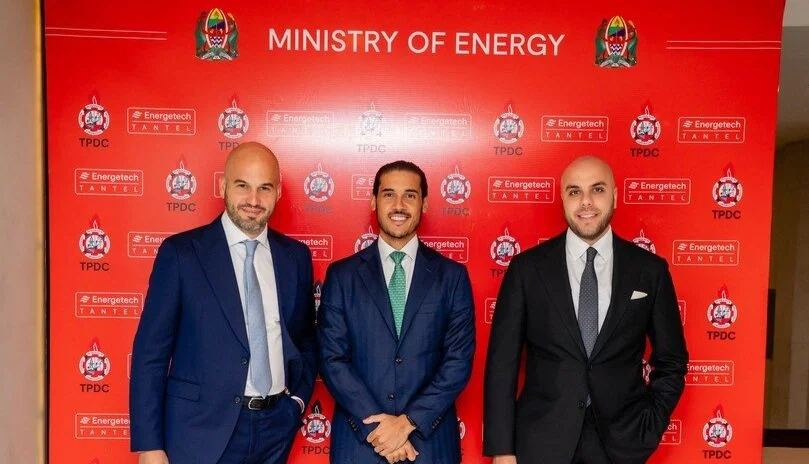Tanzania’s Regional Gas Ambitions Reignite Spotlight on FIRST E&P’s East African Play
With new LNG partnerships, regional diplomacy, and cross-African E&P interest rising, Nigeria’s FIRST E&P may have struck its Mnazi Bay North MoU at just the right time.
TPDC and Energetech-Tantel
Dar Es Salaam | Lagos | Kinshasa, July 23, 2025 – Tanzania’s energy diplomacy is having a moment.
In the space of two weeks this July, the government in Dar es Salaam has signed a $100 million modular LNG development agreement with Energetech-Tantel, and launched a bilateral hydrocarbons committee with the Democratic Republic of Congo. Both developments underscore the country’s fast-tracked ambition to position itself as a regional gas hub for Southern and East Africa. But they also breathe new relevance into a low-key but high-potential agreement from earlier this year: the April 2025 Memorandum of Understanding between the Tanzania Petroleum Development Corporation (TPDC) and Nigeria’s FIRST Exploration & Petroleum Development Company (FIRST E&P) to explore the Mnazi Bay North Block.
At the time, the MoU received little fanfare. But viewed against this month’s burst of policy and project activity—and with growing attention on intra-African partnerships in upstream oil and gas—it now reads as more than just a bilateral exploration pact. It’s a visible manifestation of a new energy geography: one where West African independents, flush with operational confidence and financial momentum, are repositioning themselves as strategic players in East Africa’s next frontier.
Dar Turns Up the Heat
On July 2, TPDC inked a landmark agreement with Energetech-Tantel for the development of a small-scale, modular LNG facility in the Lindi region, targeting a 2026 commissioning timeline. The $100 million project, expected to produce 0.2–0.4 mtpa, will serve both domestic and cross-border markets within the SADC and East African Community (EAC) zones. TPDC Managing Director Mussa Makame affirmed that the project aligns with national industrialisation and energy access goals and will support regional trade corridors via land and sea.
Just six days later, on July 8, Tanzania and the Democratic Republic of Congo launched a Joint Technical Committee on oil and gas cooperation. The committee will oversee cross-border seismic and geological coordination, joint data initiatives across the Lake Tanganyika Graben, and preliminary work on pipeline linkages. For Tanzania, these are more than symbolic gestures—they mark a maturation of energy diplomacy into operational frameworks.
Together, the July events reflect a deliberate pivot from long-term energy ambitions to near-term infrastructure and policy execution. And in doing so, they cast a new light on earlier developments—especially deals like the FIRST E&P MoU—that now find themselves squarely in the path of Tanzania’s rising gas tide.
A Nigerian Pioneer Crosses the Continent
FIRST E&P, a Lagos-based upstream independent, entered into the Mnazi Bay North MoU with TPDC in April 2025. The agreement covers joint studies to assess the geological and commercial viability of a northern extension of the Mnazi Bay Basin, an area adjacent to a field operated by Maurel & Prom, one of Tanzania’s key gas producers.
The MoU marked FIRST E&P’s first disclosed venture outside of West Africa, and it carried immediate symbolic weight: a high-performing Nigerian operator planting a flag in East Africa, with intentions to bring capital, capacity, and pan-African credibility to one of the continent’s most underexplored gas corridors.
At the time, the move may have seemed speculative. But three months later, and with Dar es Salaam plodding on, full steam ahead, the Mnazi Bay North initiative appears more aligned with regional trends than ever.
Momentum at Home, Vision Abroad
FIRST E&P’s East African expansion comes amid a phase of rapid gains in its home market. In May, the company marked the offloading of its 100th crude cargo from the Anyala Field—part of its joint venture with NNPC Upstream Investment Management Services (NUIMS). Since 2020, the JV has delivered over 15 million barrels to market, a critical boost to Nigeria’s production curve during a period of sectoral flux.
Shortly after, the company announced a significant hydrocarbon discovery at the Songhai Field, within OML 85, with preliminary assessments pointing to a major reserves addition. That came on the heels of its landmark acquisition of Shell’s onshore assets as part of the Renaissance Consortium—solidifying FIRST E&P’s financial strength and production base.
Notably, the firm has maintained a strong social license, disbursing ₦287 million under its Impact FIRST community program in March to fund grassroots development in Nigeria’s oil regions.
Collectively, these milestones paint a picture of a mid-sized African independent now ready to scale outward—capable of meeting new jurisdictional expectations while applying lessons from a complex home operating environment.
Pan-African Energy, Reimagined
In hindsight, the April MoU was more than a speculative play—it was a leading indicator of the evolving dynamics within African upstream strategy.
For Tanzania, hosting a strong Nigerian operator on its underdeveloped southern flank bolsters its position as a continental integration hub. For FIRST E&P, embedding in a market now demonstrating regulatory activation and regional alignment provides strategic upside at minimal initial capital exposure.
Equally important is the geopolitical signal: a Lagos–Dar axis is emerging in African hydrocarbons, not built on donor capital or multinational blueprints, but on homegrown capacity, mutual interest, and a shared appetite for risk.
As African energy continues its strategic pivot, threading Paris-aligned decarbonisation frameworks with regional energy security imperatives—expect to see more stories like this one. In that light, the Mnazi Bay North MoU may yet be remembered not as a quiet footnote, but as a first mover in a reimagined era of African upstream collaboration.

